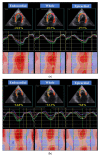Left and Right Myocardial Functionality Assessed by Two-Dimensional Speckle-Tracking Echocardiography in Cats with Restrictive Cardiomyopathy
- PMID: 34071192
- PMCID: PMC8226601
- DOI: 10.3390/ani11061578
Left and Right Myocardial Functionality Assessed by Two-Dimensional Speckle-Tracking Echocardiography in Cats with Restrictive Cardiomyopathy
Abstract
The endomyocardial form of restrictive cardiomyopathy (EMF-RCM), a primary disorder of the myocardium, is one of the diseases with poor prognosis in cats. We hypothesized that both the left and right myocardial functional abnormalities may occur in cats with EMF-RCM, causing this disease pathophysiology and clinical status. Out of the 25 animals included in this study, 10 were client-owned cats with EMF-RCM, and 15 were healthy cats. In this study, cats were assessed for layer-specific myocardial function (whole, endocardial, and epicardial) in the left ventricular longitudinal and circumferential directions, and right ventricular longitudinal direction, via two-dimensional speckle-tracking echocardiography (2D-STE). Cats with EMF-RCM had depressed left ventricular myocardial deformations both in systole (whole longitudinal strain, epicardial longitudinal strain, and endocardial circumferential strain) and diastole (early and late diastolic longitudinal strain rates, and late diastolic circumferential strain rate) compared to controls. Furthermore, some right ventricular myocardial deformations (systolic longitudinal strain in epicardial layers, and endocardial-to-epicardial strain ratio) were significantly differerent in cats with EMF-RCM. Myocardial function assessed by 2D-STE could reveal left and right myocardial dysfunction.
Keywords: endomyocardial fibrosis; feline; heart; restrictive cardiomyopathy; speckle-tracking echocardiography; strain; strain rate.
Conflict of interest statement
The authors declare no conflict of interest.
Figures




Similar articles
-
Early detection of myocardial dysfunction in a cat that gradually progressed to endomyocardial form of restrictive cardiomyopathy.BMC Vet Res. 2021 Aug 14;17(1):274. doi: 10.1186/s12917-021-02987-7. BMC Vet Res. 2021. PMID: 34391430 Free PMC article.
-
Layer-specific myocardial function in asymptomatic cats with obstructive hypertrophic cardiomyopathy assessed using 2-dimensional speckle-tracking echocardiography.J Vet Intern Med. 2019 Jan;33(1):37-45. doi: 10.1111/jvim.15339. Epub 2018 Nov 29. J Vet Intern Med. 2019. PMID: 30499128 Free PMC article.
-
Quantitative analysis of endocardial and epicardial left ventricular myocardial deformation-comparison of strain-encoded cardiac magnetic resonance imaging with two-dimensional speckle-tracking echocardiography.J Am Soc Echocardiogr. 2012 Nov;25(11):1179-88. doi: 10.1016/j.echo.2012.07.019. Epub 2012 Aug 28. J Am Soc Echocardiogr. 2012. PMID: 22951120
-
Does layer-specific strain using speckle tracking echocardiography improve the assessment of left ventricular myocardial deformation? A review.Arch Cardiovasc Dis. 2020 Nov;113(11):721-735. doi: 10.1016/j.acvd.2020.05.007. Epub 2020 Sep 3. Arch Cardiovasc Dis. 2020. PMID: 32891564 Review.
-
Echocardiographic Differentiation of Pericardial Constriction and Left Ventricular Restriction.Curr Cardiol Rep. 2022 Nov;24(11):1599-1610. doi: 10.1007/s11886-022-01774-6. Epub 2022 Aug 30. Curr Cardiol Rep. 2022. PMID: 36040551 Review.
Cited by
-
Early detection of myocardial dysfunction in a cat that gradually progressed to endomyocardial form of restrictive cardiomyopathy.BMC Vet Res. 2021 Aug 14;17(1):274. doi: 10.1186/s12917-021-02987-7. BMC Vet Res. 2021. PMID: 34391430 Free PMC article.
-
Detection of Congestive Heart Failure and Myocardial Dysfunction in Cats With Cardiomyopathy by Using Two-Dimensional Speckle-Tracking Echocardiography.Front Vet Sci. 2021 Nov 15;8:771244. doi: 10.3389/fvets.2021.771244. eCollection 2021. Front Vet Sci. 2021. PMID: 34869741 Free PMC article.
-
Post-carvedilol myocardial function in cats with obstructive hypertrophic cardiomyopathy.Front Vet Sci. 2025 Mar 28;12:1571850. doi: 10.3389/fvets.2025.1571850. eCollection 2025. Front Vet Sci. 2025. PMID: 40225764 Free PMC article.
-
Unusual diagnosis of feline cardiac lymphoma using cardiac needle biopsy.BMC Vet Res. 2022 Jun 28;18(1):251. doi: 10.1186/s12917-022-03357-7. BMC Vet Res. 2022. PMID: 35764997 Free PMC article.
-
IL-35 Ameliorates Myocardial Strain in Mice with T2DM-Induced Cardiac Injury: Assessment by Layer-Specific Strain.Diabetes Metab Syndr Obes. 2025 May 10;18:1551-1562. doi: 10.2147/DMSO.S510594. eCollection 2025. Diabetes Metab Syndr Obes. 2025. PMID: 40375942 Free PMC article.
References
-
- Luis Fuentes V., Abbott J., Chetboul V., Côté E., Fox P.R., Häggström J., Kittleson M.D., Schober K., Stern J.A. ACVIM consensus statement guidelines for the classification, diagnosis, and management of cardiomyopathies in cats. J. Vet. Intern. Med. 2020;34:1062–1077. doi: 10.1111/jvim.15745. - DOI - PMC - PubMed
-
- Amaki M., Savino J., Ain D.L., Sanz J., Pedrizzetti G., Kulkarni H., Narula J., Sengupta P.P. Diagnostic concordance of echocardiography and cardiac magnetic resonance-based tissue tracking for differentiating constrictive pericarditis from restrictive cardiomyopathy. Circ. Cardiovasc. Imaging. 2014;7:819–827. doi: 10.1161/CIRCIMAGING.114.002103. - DOI - PubMed
-
- Kusunose K., Dahiya A., Popović Z.B., Motoki H., Alraies M.C., Zurick A.O., Bolen M.A., Kwon D.H., Flamm S.D., Klein A.L. Biventricular mechanics in constrictive pericarditis comparison with restrictive cardiomyopathy and impact of pericardiectomy. Circ. Cardiovasc. Imaging. 2013;6:399–406. doi: 10.1161/CIRCIMAGING.112.000078. - DOI - PubMed
Grants and funding
LinkOut - more resources
Full Text Sources
Research Materials
Miscellaneous

